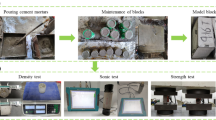Abstract
The pressure at the front and the pressure impulse of blast waves generated in a cylindrical tube by the expanding products of the nonideal detonation of low-porosity charges prepared by pressing of fine-grained powders of aluminum, Teflon, and RDX were measured. The measured parameters are compared to the same parameters of blast waves produced by the detonation of TNT charges of identical mass. The relative quantities were used to evaluate the effectiveness of blast waves with respect to those generated by TNT. Mixed compositions differing in the shape (brand) of the aluminum powder particles and the ratio between the components at 30% RDX are studied. It is shown that, for the investigated compositions, the pressure at the leading front of the wave exceeds the pressure achieved during TNT explosion on average by 10–30%, almost independently of the distance traveled along the tube in the range from 0.8 to 3.8 m. The dependence of the wave amplitude on the particle shape and aluminum content was weak. In the same range of distances, the relative pulse pressure increases strongly, from 0.5 to 2.1 and higher, mainly due to an increase in the width of the wave. This result is of interest from the point of view of achieving a high pressure impulse of the blast wave in an area remote from the charge. The obtained data suggest that RDX mainly reacts in the detonation wave, with the chemical transformation of Teflon and aluminum in the detonation wave and near-to-charge zone occurring, if at all, to a small extent. On the contrary, as the blast wave front moves through the channel, the burning of aluminum in the fluoride formed during the decomposition of Teflon provides an appreciable support to the blast wave, causing a significant increase in the pressure impulse.
Similar content being viewed by others
References
A. A. Sulimov, A. A. Borisov, B. S. Ermolaev, et al., Russ. J. Phys. Chem. B 3, 789 (2009).
A. A. Borisov, A. A. Sulimov, M. K. Sukoyan, et al., Russ. J. Phys. Chem. B 3, 936 (2009).
S. B. Viktorov, S. A. Gubin, I. V. Maklashova, et al., Khim. Fiz. 24(12), 22 (2005).
F. A. Baum, L. P. Orlenko, K. P. Stanyukovich, et al., Physics of Explosion (Nauka, Moscow, 1975) [in Russian].
Author information
Authors and Affiliations
Corresponding author
Additional information
Original Russian Text © A.A. Sulimov, B.S. Ermolaev, M.K. Sukoyan, 2012, published in Khimicheskaya Fizika, 2012, Vol. 31, No. 6, pp. 16–22.
Rights and permissions
About this article
Cite this article
Sulimov, A.A., Ermolaev, B.S. & Sukoyan, M.K. Blast waves in a cylindrical channel generated by the nonideal detonation of aluminum-Teflon-RDX high-density formulations. Russ. J. Phys. Chem. B 6, 397–403 (2012). https://doi.org/10.1134/S1990793112060073
Received:
Published:
Issue Date:
DOI: https://doi.org/10.1134/S1990793112060073




